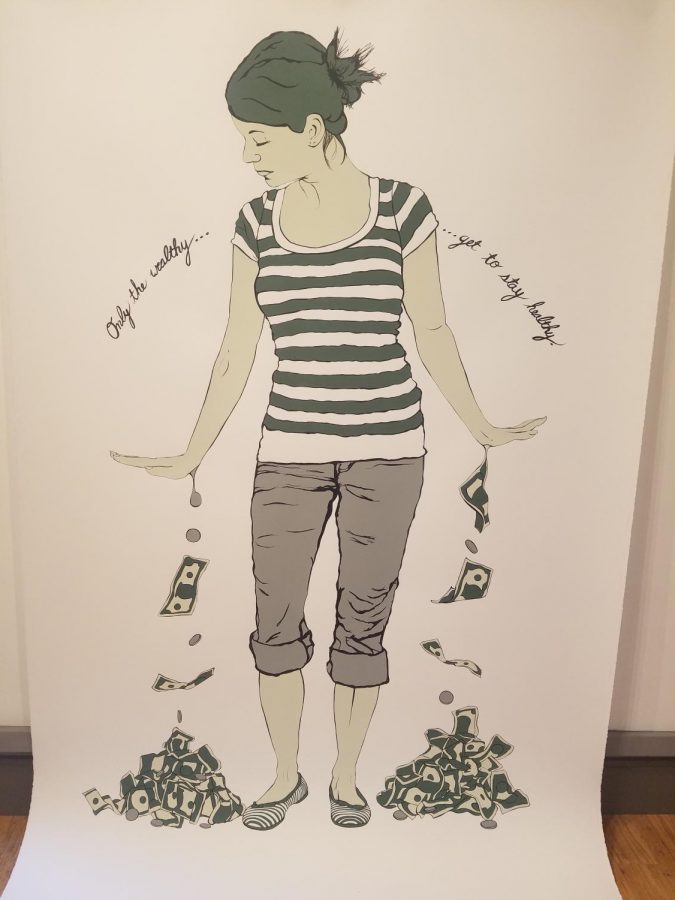Art exhibit displays scale, human connection to nature and body
“Cobra” by Tonja Torgerson displayed in the Pace Galleries.
The green figure poses at ease inside the white canvas as money bleeds from her wrists onto the canvas’s edge, resting on the floor. Behind her figure, in a cursive font, arches the phrase “Only the wealthy get to stay healthy.”
Artist Tonja Torgerson said the piece, titled “Cobra,” focuses on the faults in health care and social economics. The Indiana University professor said it will always have a special place in her heart because it was the first piece where she began to focus on large scale figures and the body.
“I’d dealt with figures before,” Torgerson said. “But mostly in self-portrait and in a smaller scale, so (‘Cobra’) was my first time doing something in full scale and understanding how important I think that is to the work and how people interact with the work.”
“Cobra” is a part of the first art exhibit, titled “Converters: Work by Amanda Smith and Tonja Torgerson,” on display for the new school year and features works that break the model of traditional art, style, and media. Artists Torgerson and Amanda Smith both feature very different pieces from their past but each artists’ work focuses on the disproportion of scale, the focus of the human connection to nature and the body, the changes people experience over time and how different individuals manage the adjustment.
The work will be on exhibit from Monday to Friday from 10 a.m. to 2 p.m. and Sunday from 1-5 p.m. at the McCutchan Art Center/Pace Galleries until Friday, Sept. 6 with a reception held 2-4 p.m. on its last night.
Torgerson said her featured, older body of work focuses on the human body, the identity people form and how the two intertwine when the body is failing.
“I think our bodies are just such a fascinating part of our identities of who we are, and how they’re connected has always been interesting to me,” Torgerson said. “We are our bodies, we tend to want to separate them out, mind and body, but I’ve always thought of them as one.”
Using a life-size scale for the individual figures during their body’s moment of crisis allows Torgerson to inspect what happens to people when they lose control over their bodies.
Torgerson said it’s important for students to take time to view these pieces not just on a computer or phone screen, but to fully understand the scale and experience the art.
Torgerson said her own art is made to fall out and extend on to the floor to give it an interesting quality that the viewer can interact with.
Like Torgerson’s body of work, Amanda Smith’s pieces are nontraditional in scale and expand on the idea of canvases and media.
Reimaginings of the paintings from the past decade, Smith’s work focuses on landscape and nature as people experience it and navigate through it. The Missouri State University assistant professor of Art said her reimagined designs lead away from her traditional canvas and paint, focusing instead on the practice of quilt making.
“(Quilting) really linked up with my sensibilities,” Smith said. “I really tend to think of space and shapes as a collage and you’re piecing different things and aspects together…The process of putting together a nontraditional quilt really aligned with the way I already made work.”
In order to compensate for depth of space through diversity in her paintings, Smith uses a variety of materials: manufactured or vintage material, her own hand-dyed or painted material and her own printed photographs from past artist residencies. Smith said this use of diverse media gives her quilted works different sizes and irregular shapes.
Smith said this idea of thinking about traditional practices in an expanded way helps keep a hold on the history of craft making while still pushing her in a new direction.
Smith hopes students at the university will learn from the works featured.
“I think it’s very nice to see the different ways that you can find connections and a renewal of interest in processes by expanding our connections,” Smith said, “That can lead to expansions of what (students) can do with the techniques they learn in school. I think that’s very important.”



